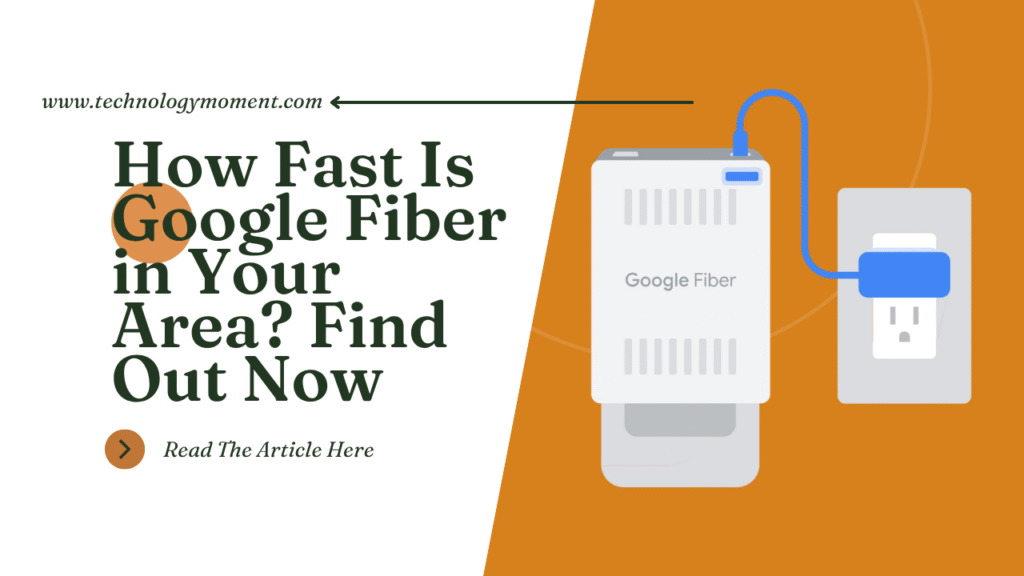
Welcome to Technology Moment, your digital home for staying ahead of the curve in this rapidly evolving tech-driven world. Whether you’re a casual reader curious about the latest innovations or a dedicated tech enthusiast constantly seeking to optimize your devices and services, we’re here to bridge the gap between information and action. And today, we’re talking about something that affects all of us, every single day—internet speed.
Let’s be real for a second: we’ve all been there. You’re in the middle of a critical Zoom meeting and your screen freezes, or you’re about to win a game and—bam—lag kicks in and ruins the moment. In Lagos, Nigeria, a digital entrepreneur we spoke to recently shared how poor connectivity cost him a key client meeting. Meanwhile, in Seoul, South Korea—known for its blazing-fast internet—a 17-year-old gamer livestreams in ultra-HD with zero buffering. The difference? Infrastructure. And that’s where Google Fiber enters the conversation.
In the U.S., particularly in cities like Kansas City and Austin, Google Fiber has been quietly yet powerfully redefining the internet experience. What started as a bold experiment by Google has now become a highly sought-after service, known for delivering internet speeds that feel like stepping into the future. Imagine downloading a full 4K movie in less than a minute or having a video call where you can see every blink, every movement, in crystal-clear detail.
But here’s the real question that brought you here: How fast is Google Fiber where you live? It’s not just about raw speed—it’s about how that speed transforms your everyday life. Whether you’re a remote worker trying to boost productivity, a parent juggling kids’ online learning, or a digital creator uploading massive video files to YouTube, speed matters. It matters a lot.
And let’s not forget availability. You might be hearing rave reviews from friends in San Antonio, but is it even in your neighborhood yet? And if it is, what are the actual speeds, prices, and plans you can choose from? That’s what this guide is all about—real talk, practical advice, and the straight facts you need to make an informed decision.
So grab your coffee, settle in, and let’s dive deep into the world of Google Fiber—where it’s available, how fast it is, and whether it’s the right move for you. Because at Technology Moment, we believe technology should work for you, not against you. Let’s find out if Google Fiber is the upgrade your life has been waiting for.
Table of Contents
Imagine sitting down to stream your favorite Netflix show, only to see the spinning wheel of death – buffering. Or maybe you’ve got a crucial video meeting, but your screen freezes just as you’re about to speak. We’ve all been there, and it’s frustrating. That’s why your internet connection matters now more than ever.
In today’s hyper-connected world, where remote work, smart homes, and 4K streaming are the norm, having a fast, reliable internet connection isn’t a luxury—it’s a necessity. Known for its blazing-fast speeds and no-nonsense service, it’s become a game-changer in the few cities lucky enough to have it.
But how fast is it? And more importantly, can you get it where you live? These are the questions we’ll explore, breaking things down so you can decide if it’s time to switch—and supercharge your digital life.
🌐 Understanding Google Fiber
To really appreciate Google Fiber, you have to understand what makes it special. This isn’t just another internet provider adding shiny logos and promises. It’s Google’s direct attempt to disrupt the traditional broadband industry. When it first launched in Kansas City in 2012, people were skeptical. After all, what did Google know about installing fiber-optic cables underground?
Turns out, quite a lot.
Unlike traditional cable or DSL connections, Google Fiber delivers fiber-optic internet directly to your home. That means information is transmitted at nearly the speed of light. For users, this translates to upload and download speeds that are often identical and incredibly fast.
Take Sarah, a freelance graphic designer in Kansas City. Before Google Fiber arrived, she struggled with lag while uploading high-resolution client files. Her workday was filled with frustration. But once she switched to Fiber, her upload times dropped from 20 minutes to just under 2. It changed the way she worked—and even how much work she could take on.
Google didn’t just offer faster speeds. They reimagined the user experience. No more endless upselling or complicated bills. Their app lets you manage everything easily—checking your usage, managing Wi-Fi settings, and even troubleshooting. And the Google Fiber login portal is designed to be simple and clean, much like everything else Google builds.
⚡ Google Fiber Speed – Just How Fast Is It?
Let’s get to the big question: how fast is fast?
Google Fiber currently offers speeds up to 2 Gigabits per second (Gbps). That’s 2,000 Mbps. For comparison, many traditional broadband services cap out at 100–300 Mbps. This means you can download a full HD movie in seconds or stream 4K content on multiple devices with zero buffering.
And unlike many other ISPs, these aren’t just “advertised” speeds. Most users report that the speeds are consistent and reliable, even during peak hours.
Consider a small business owner in Austin, Texas, who runs a hybrid office setup. With multiple employees joining Zoom calls, transferring files, and running cloud-based apps simultaneously, he noticed a huge drop in lag time and system crashes after switching to Google Fiber. Not only did productivity improve, but so did his team’s morale.
If you’re curious about what speeds you’d get, Google offers its own Google Fiber speed test tool, available through the app and website. It’s straightforward and refreshingly honest.
And if you’re comparing with other providers? Well, speed tests across cities like Salt Lake City, Atlanta, and Provo routinely show Google Fiber outperforming competitors by a wide margin in both download and upload rates.
💰 Google Fiber Plans & Pricing
One of the best things about Google Fiber is that it doesn’t overcomplicate the pricing. No hidden fees. No “promotional” rates that skyrocket after six months.
Here’s how the current plans generally look (prices can vary slightly by location):
- 1 Gig Plan: Up to 1 Gbps upload/download, perfect for streaming, working from home, gaming, and smart home setups.
- 2 Gig Plan: Up to 2 Gbps download and 1 Gbps upload. This plan is built for power users – think large households, content creators, or digital professionals who need every bit of bandwidth.
What makes these plans stand out isn’t just the speed—it’s the value. You often get free installation, no contracts, and no data caps. That’s rare in the broadband industry.
Let’s take an example from San Antonio. Maria, a single mom and school teacher, was tired of her cable provider hiking prices every year. She needed reliable internet for her remote teaching sessions and her kids’ online learning. After switching to Google Fiber’s 1 Gig plan, she saved $30 a month and no longer had to fight for bandwidth when her kids streamed Disney+.
Another underrated perk? Google includes a Wi-Fi 6 router with its plans, optimized for speed and coverage. So, whether you’re in the living room or tucked away in a basement office, you’ll stay connected.
And if you’re ever unsure about what plan is right for you, their customer service isn’t just responsive—it’s human. That’s a refreshing change from endless hold music and robotic replies.
Where Is Google Fiber Available?
Imagine moving into a brand-new home in the heart of Austin, Texas. The sunlight pours in, your furniture is in place, and you’re ready to work remotely — but your internet is spotty. Now imagine discovering that your neighborhood has access to Google Fiber. That moment of relief is what many residents in select U.S. cities have experienced when they found out that Google Fiber was live in their zip code.
But here’s the reality: Google Fiber isn’t available everywhere yet. It began as a bold project in Kansas City, where the first residents were stunned to experience internet speeds 100 times faster than what they were used to. Since then, it has expanded to select cities like Austin, San Antonio, Atlanta, Salt Lake City, Huntsville, and parts of North Carolina and Utah.
It’s kind of like using a pizza delivery app — type in your location and boom, you’ll know if you’re in luck or not. If you’re outside the coverage zone, don’t lose hope; Google Fiber is constantly expanding, and new neighborhoods are being added each year. For example, in 2024, they announced their next expansion into parts of Nebraska and Idaho, proving they’re not slowing down.
How to Use the Google Fiber Speed Test
You don’t need to be a tech wizard to check how fast your internet is. If you’re using Google Fiber or even considering it, running a speed test can give you a clear picture of what you’re working with.
Take the story of Ravi in San Antonio. A software developer who relied heavily on video conferencing and cloud storage, he upgraded to Google Fiber but wasn’t sure if he was getting the full benefits. A quick visit to the Google Fiber Speed Test changed everything. Within seconds, Ravi could see that he was getting 950+ Mbps both for download and upload — virtually flawless for his work-from-home setup.
The test is simple. You open the link, click “Start Test,” and watch the numbers fly. What’s great is that it not only shows your download and upload speeds, but also ping/latency, which matters a lot for gamers and video callers. If you’re getting results that are far below your subscribed plan, it might be time to reboot your router or reach out to support, which leads us to the next point.
Dealing with Outages and Support
No one likes it when the internet goes down, especially during a live stream, virtual class, or online gaming session. While Google Fiber boasts a very high uptime percentage, outages can still happen, especially during network upgrades or bad weather.
Let me tell you about Maria, a high school teacher from Atlanta. One Monday morning, right before a virtual parent-teacher meeting, her connection dropped. She panicked. But instead of waiting endlessly on hold like you might with some other ISPs, she opened the Google Fiber app, which gave her an immediate status update and even an estimated resolution time.
This is where Google Fiber customer service stands out. They offer real-time alerts through the app and website, and if you do need to call, the response times are usually quick and human. No 30-minute hold music or being bounced between departments.
If the issue is local, you might get a text update. If it’s something bigger, they’ll usually update their official Fiber status page and let you know what’s going on. The point is — while no provider is immune to technical issues, Google Fiber is refreshingly transparent when problems happen.
Is Google Fiber Right for You?
This is the big question — and the answer depends on what kind of internet user you are.
He regularly uploads massive 4K files to clients across the globe. With his old provider, it took over an hour to upload a single project. When he switched to Google Fiber, that same file uploaded in minutes.
But maybe you’re like Sarah in North Carolina, who mainly uses the internet to check emails, stream Netflix, and scroll through Pinterest. Even she noticed a huge difference. Her videos loaded instantly, and Zoom calls with her long-distance boyfriend were crystal clear. Even casual users can feel the difference.
Now, is it for everyone? Not necessarily. If you’re in a rural area where it’s not yet available, or you’re on a super tight budget, you might have to wait or consider alternatives for now. But for those lucky enough to be in a Fiber zone, the combination of speed, reliability, and support makes it a top-tier choice.
Future of Google Fiber
The story of Google Fiber isn’t just about speed—it’s about setting a new standard for what internet service should be. Over the past decade, it’s slowly grown from a bold experiment in Kansas City to a serious player in the internet world. But if you’re wondering where it’s headed next, the answer is: bold, targeted, and quietly ambitious.
Let’s start with expansion. Unlike traditional ISPs that aggressively stretch into every zip code, Google Fiber has taken a quality-first, location-smart approach. They’ve focused on rolling out in tech-savvy or underserved cities where demand for high-speed internet is critical. Think of places like San Antonio, Austin, Salt Lake City, and even smaller hubs like West Des Moines. These aren’t random picks—they’re communities with growth potential, eager for change, and tired of monopoly ISPs.
Shortly, Google Fiber is also exploring multi-gigabit speeds, including 5 Gig and 8 Gig plans, which might sound like overkill—until you consider how many connected devices live in the average home today. With AI models, smart home tech, and remote work on the rise, this kind of bandwidth won’t just be a luxury. It’ll be a necessity.
There’s also a strong push into wireless fiber, especially in areas where traditional fiber lines are costly or impractical. This tech could revolutionize how quickly new cities come online with Google Fiber, cutting build time from years to months or even weeks.
If you’re waiting for Google Fiber to hit your neighborhood, keep an eye on the Google Fiber map and local news. In cities where they’re laying new groundwork, the buzz usually starts with community meetings, local permits, and job listings. It’s quiet, but it’s coming. And when it does, the internet experience there changes fast.
✅ Conclusion
So, how fast is Google Fiber in your area? Well, if you’re one of the lucky ones living in a Fiber zone, the answer might just be: blazing fast. With symmetrical speeds of up to 8 Gbps, zero data caps, and top-notch reliability, it’s not just another internet provider—it’s a game-changer.
But beyond the numbers, this is about freedom. The freedom to stream your favorite shows in 4K without buffering. The freedom to upload giant video files or games without the dreaded lag spike.
If Google Fiber isn’t in your area yet, that doesn’t mean you’re out of luck. Keep checking their availability map and sign up for notifications. Change is slow, but when Google Fiber expands, it transforms the landscape for everyone in that city. Prices drop, speeds increase, and customers finally have a real choice.
In the end, it’s not just about megabits and pricing tiers—it’s about building an internet experience you don’t have to think about. One that just works beautifully.
❓Frequently Asked Questions (FAQs)
How fast is Google Fiber?
Let’s be real—Google Fiber’s actual speeds are often faster than advertised, depending on your setup. Users report consistently reaching close to 940 Mbps on a 1 Gig plan, and even multi-Gig speeds with newer plans. Unlike some ISPs that advertise “up to” speeds, Google Fiber is known for delivering.
What cities does Google Fiber serve right now?
As of 2025, Google Fiber is available in cities like Kansas City, Austin, San Antonio, Salt Lake City, Atlanta, and Nashville, with expansion happening quietly in places like North Carolina, Arizona, and Iowa. Check their Google Fiber map for the latest.
How can I log in to Google Fiber?
It’s simple. Visit fiber.google.com, click on the login button, and enter your account credentials. You can also manage your service through the Google Fiber app, which allows you to check your speed, schedule installations, and monitor connected devices.
What do I do if there’s a Google Fiber outage?
Outages are rare but not impossible. First, check the Google Fiber status page or app. You can also contact Google Fiber customer service—they’re known for being responsive and helpful.
Can I test my Google Fiber speed myself?
Yes! Google even offers its speed test tool at speedtest.googlefiber.net, which is tailored for their network. Or try trusted options like Ookla. Just remember—Wi-Fi can bottleneck even a fast plan, so test with Ethernet when you can.













